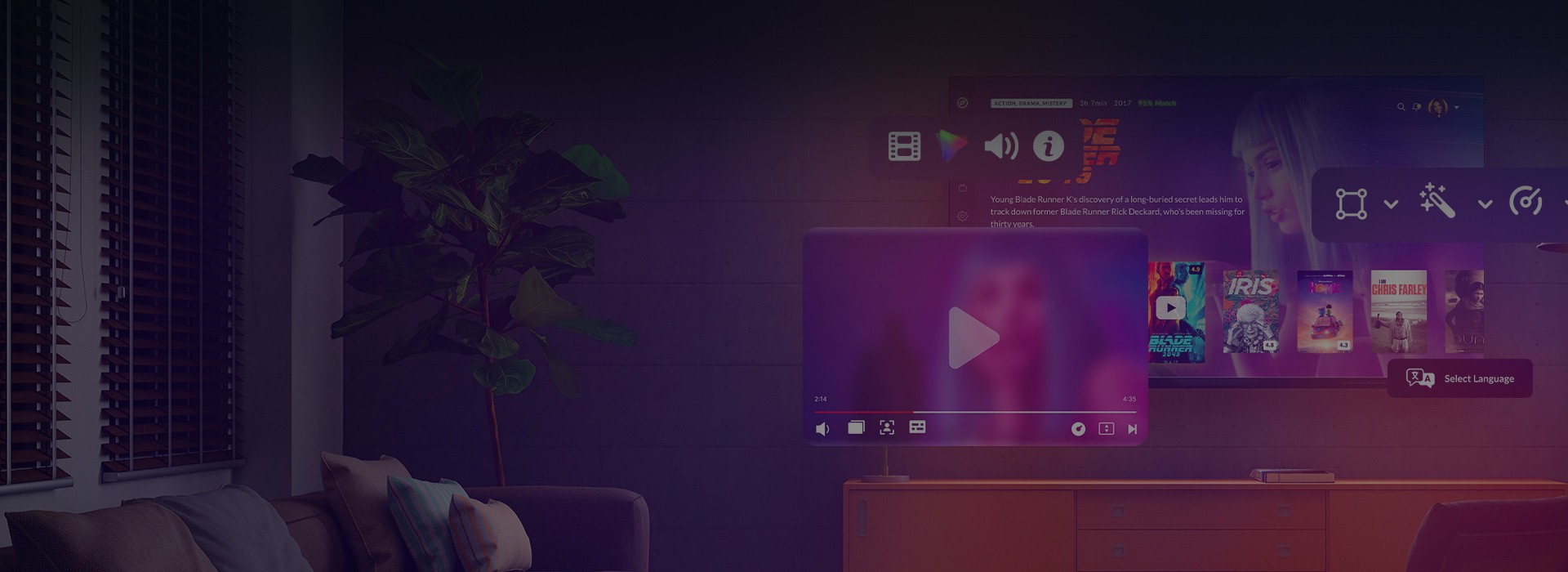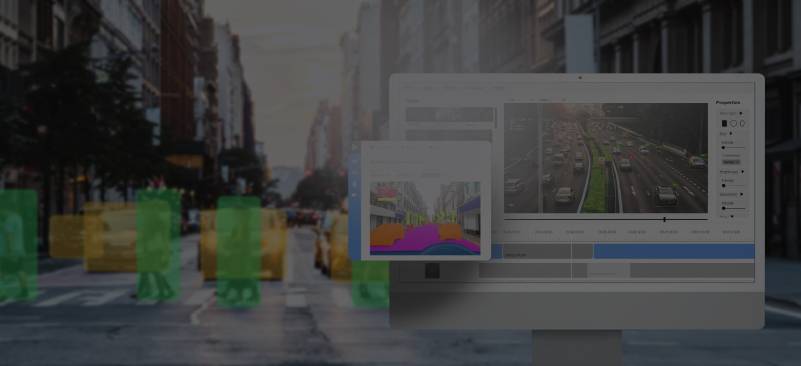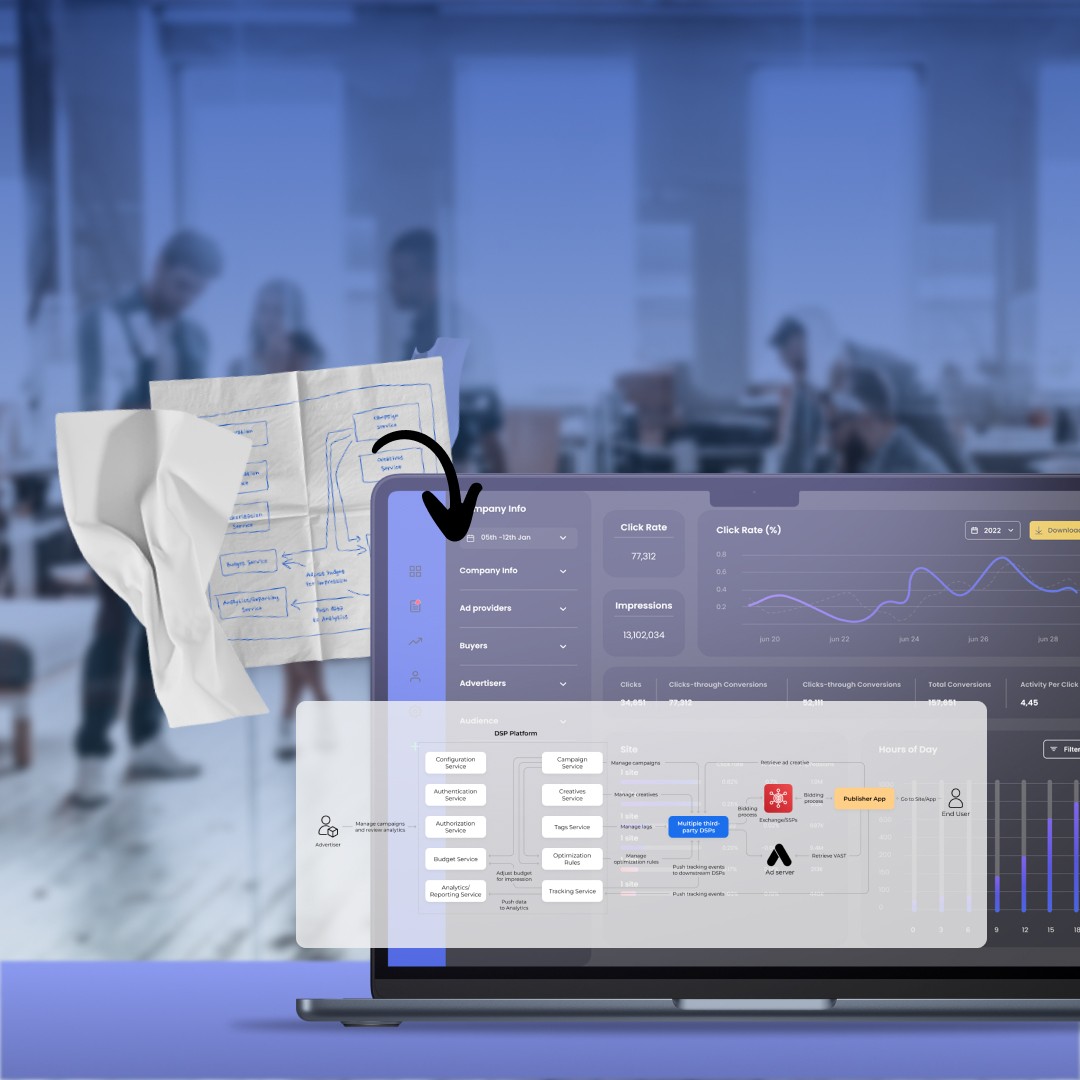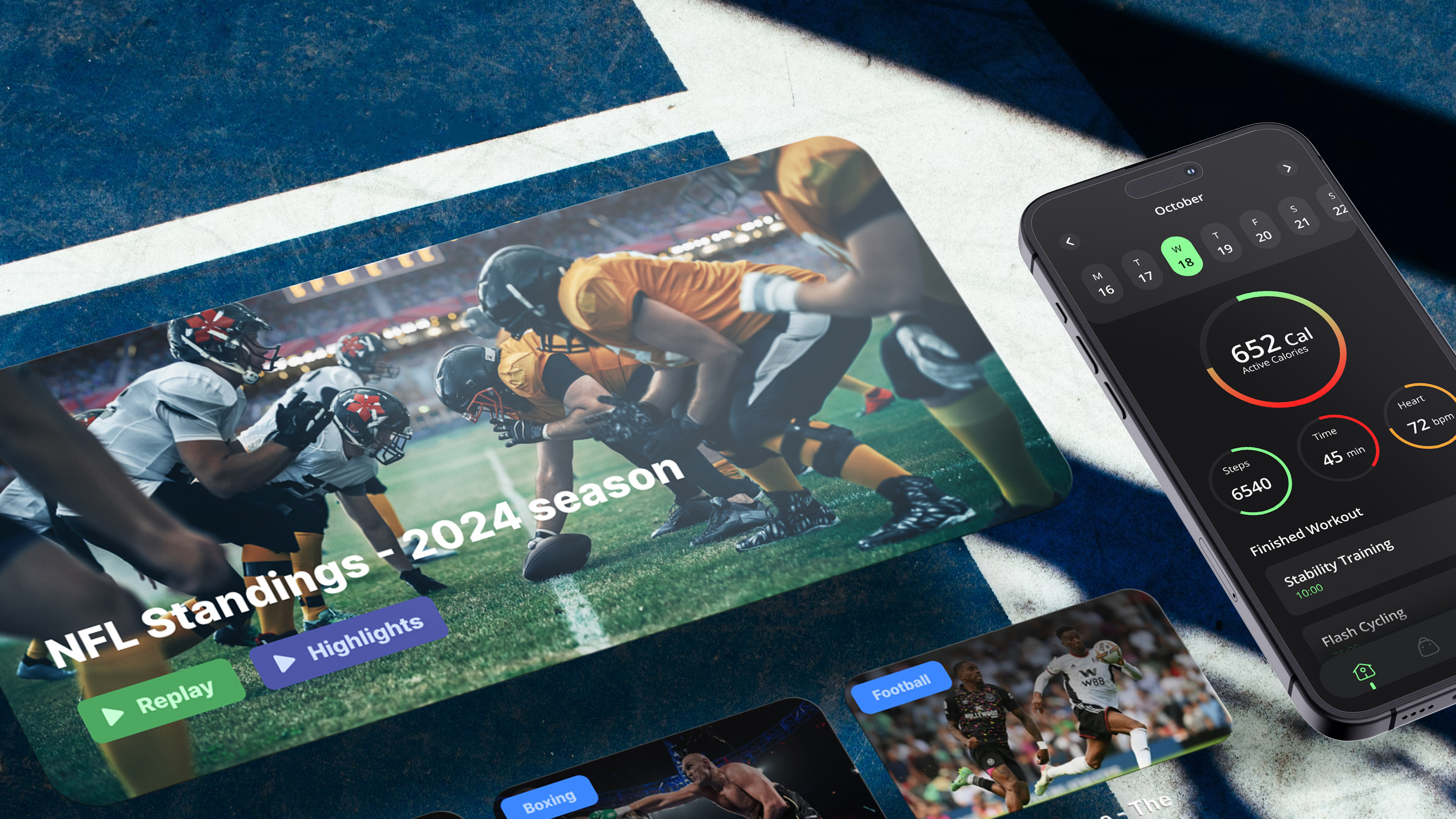Launching a Video-on-Demand (VoD) app can be a great opportunity — but also a technically demanding process. Users expect more than just content access. They want instant playback, smooth performance on any screen, personalized viewing, easy navigation, and a polished experience from start to finish.
So, what does it take to deliver all that?
To build a VoD platform that works at scale — and keeps both users and stakeholders happy — you need to get a few core things right from the very beginning:
Delivering consistent streaming quality across different networks and screen sizes
Users might watch content over fiber, mobile data, or public Wi-Fi — and expect the same smooth playback everywhere. To meet that demand, your platform needs adaptive bitrate streaming, intelligent buffering, and dynamic video compression that adjusts quality in real time based on connection speed and device capabilities.
Protecting your content from unauthorized access and piracy
Whether you’re distributing exclusive shows or premium live streams, securing content is critical. That means implementing DRM (Digital Rights Management), token-based authorization, content encryption, and watermarking strategies that discourage redistribution without hurting performance.
Reaching users globally with low latency and CDN optimization
Latency isn’t just a live-streaming issue. For VoD, fast startup time and minimal buffering rely heavily on smart content delivery infrastructure. A robust CDN strategy helps serve users from geographically distributed nodes, reducing lag and improving quality across regions — especially in mobile-first or bandwidth-constrained markets.
Expanding multi-platform reach to maximize engagement
Today’s viewers expect seamless experiences across phones, tablets, Smart TVs, desktops, and even game consoles. Making your app available and optimized for a wide range of devices increases accessibility, extends your brand presence, and improves user retention. That requires responsive design, platform-specific UI tweaks, and native app development for ecosystems like Android TV, Apple TV, Samsung Tizen, LG webOS, and many more.
Case in point: scaling a VoD app for the Smart TV landscape
A youth-focused broadcaster wanted a Smart TV app with both live and on-demand video, tailored for Tizen-based and other connected platforms. We delivered a multi-platform solution that favored quick and easy configurations. As a result, the client expanded market reach and improved ad revenue.

Personalizing the experience to keep viewers engaged and reduce churn
One-size-fits-all content presentation doesn’t cut it anymore. Personalization features — like smart recommendations, “continue watching” lists, and behavior-based carousels — encourage users to spend more time on the platform and reduce drop-off. AI-driven algorithms power more accurate recommendations that match individual preferences, keeping viewers engaged and eager to watch more.
Integrating with tools like CRMs, CMSs, and analytics platforms to streamline content management operations
Behind the scenes, a VoD app needs to play well with your broader business ecosystem. Integration with CRMs helps you track user journeys, while CMSs simplify content updates and publication workflows. Analytics platforms enable real-time performance monitoring, user tracking, and trend discovery.
Gathering and using the right data to fuel platform growth and monetization
From viewer behavior to content performance, having access to meaningful data lets you make smarter business decisions. By collecting metrics like watch time, drop-off points, and engagement rates, you can fine-tune your catalog, refine recommendations, test monetization strategies, and respond quickly to market trends.
In the next sections, we’ll take a closer look at how VoD apps are built — step by step. We’ll highlight common pitfalls to watch out for, break down the key cost drivers, and then explore popular content monetization models that can maximize your platform’s revenue potential. These insights will help you plan a smoother and more successful VoD development process from start to finish.
Let’s break down the VoD app development process
Building a VoD app isn’t something that happens overnight. It’s a multi-stage process that combines strategy, design, development, and ongoing optimization. Here’s a step-by-step look at how it typically comes together — from initial concept to live platform.
1. Planning and conceptualization
Everything starts with a clear vision. Who is your target audience? What type of content will you offer — original productions, licensed media, or user-generated videos? What’s your monetization model — subscriptions, ads, pay-per-view?
This is also the stage to outline your roadmap, covering both technical implementation and go-to-market strategy.
2. UI and UX design and prototyping
Next comes design — and in VoD, it’s critical. Users expect an intuitive, attractive interface that makes it easy to browse, search, and watch.
Prototypes help you validate the layout and navigation early, before any code is written. That saves time later and helps align your team around a shared vision.
3. Content acquisition and licensing
If you’re offering third-party content, securing the proper rights is non-negotiable. Make sure all content licensing is in place and clearly defines where, how, and for how long you can distribute videos.
Decide whether you’ll be sourcing original content, licensing from studios, or allowing users to upload their own.
4. CMS selection and integration
The content management system is the backbone of your VoD app. A headless CMS designed for video platforms allows you to store and organize metadata — like titles, descriptions, genres, ratings — and connect everything seamlessly to the frontend.
The right CMS also streamlines editorial workflows, manages user roles, and acts as the central hub for content operations.
5. Backend development
On the backend, you’ll need a scalable architecture that handles streaming, user accounts, payments, content protection, and integrations.
This is where you’ll implement DRM, encryption, and watermarking to protect your video assets.
You’ll also connect to CDNs to deliver content efficiently to users across the globe, ensuring fast load times and minimal buffering.
6. Frontend and mobile app development
With the backend in place, it’s time to build the user-facing apps — for web, mobile devices, and smart TVs.
Frontend teams use CMS APIs to display video content dynamically and implement features like search, recommendations, watch history, user profiles, and notifications.
Depending on your goals, this could mean building native apps or using cross-platform tools to speed up delivery.
7. Testing and quality assurance
Before launch, the entire system needs to be thoroughly tested — including app functionality, playback performance, CMS workflows, and cross-device compatibility.
Test scenarios should cover everything from video uploads and metadata syncing to streaming quality under different network conditions.
8. Deployment and release
Once everything has been checked, your app is ready to go live. This includes deploying to app stores, web platforms, or connected TV ecosystems.
Make sure you comply with all platform requirements, content regulations, and privacy laws in your target regions.
Keep an eye on early user feedback to catch and resolve any issues quickly.
9. Marketing and user acquisition
No matter how great your app is, you’ll need to promote it. Tailor marketing campaigns to your target audience and highlight the unique features of your content offering.
Whether you focus on niche communities or target a broader audience, strong messaging and visibility are key to growing your user base.
10. Maintenance, analytics, and continuous improvement
Launching the app is only the beginning. Use analytics to understand how users interact with your content — what they watch, how long they stay, and where they drop off.
Regular updates, performance optimizations, and new features will help you stay competitive. Your VoD software should evolve along with your audience and business needs.
Pitfalls to avoid when developing a VoD app
Even with careful planning, building a VoD app can come with unexpected hurdles.
Take one of our recent projects — a European telecom provider faced several challenges with their existing VoD service.
Their web platform was resource-heavy, causing slow load times and high bandwidth use. On top of that, the mobile user interface was basic and didn’t meet user expectations, risking loss of market share. Content management and advertising capabilities also needed a serious upgrade.
Here’s how we helped turn things around:
- Rebuilt the frontend from scratch to create a sleek, mobile-friendly UI that’s fast and responsive.
- Implemented adaptive streaming technology (Microsoft Smooth Streaming) to adjust video quality dynamically, minimizing buffering.
- Secured content with PlayReady DRM, encryption, and strong session management to protect valuable media assets.
- Integrated a flexible CMS that manages all video metadata, workflows, and user roles smoothly.
- Developed a custom advertising module allowing precise ad targeting, scheduling, and detailed analytics.
- Boosted user engagement with personalized recommendations, advanced search options, customizable themes, and social features.
Most importantly, we built everything on a secure, scalable architecture with ongoing testing and vulnerability checks to keep the platform reliable.
The result was a competitive, user-focused VoD platform that not only improved performance but also became a cornerstone of the client’s on-demand entertainment strategy.
Looking to build a tailored VoD platform for your business?
Our custom VoD application development services cover everything from concept to launch.
What it will cost to build a VoD platform
When it comes to developing a Video-on-Demand (VoD) platform, the cost can vary significantly depending on your approach. Whether you choose a custom-built solution or a white-label platform, the budget implications differ considerably.
Custom VoD
- High upfront cost
- Full control
- Longer time to launch
- Scalable but complex
White-label VoD
- Lower initial cost
- Limited control
- Fast launch
- Pay as you grow
Custom VoD platform costs
Building a custom VoD platform from scratch demands a higher initial investment (CapEx). This is because you’re not just licensing a solution; you’re developing a tailored platform with the features, performance, and scalability that align with your business goals. With this custom development approach, you gain full control over the platform’s design and functionality.
However, it’s essential to consider that operational expenses (OpEx) don’t disappear after the initial build. You’ll need to account for costs like hosting, content delivery, and regular platform maintenance. Additionally, scaling your platform to handle more users and streaming hours could incur ongoing costs, especially when you factor in content encoding, CDNs, and additional technical support.
White-label VoD platform costs
A white-label VoD solution typically offers a lower upfront cost, as you’re licensing an already-built platform. This approach often follows a pay-as-you-go pricing model, where fees scale based on the number of users or the amount of streaming hours. This can be a more cost-effective choice for startups or smaller companies, especially in the early stages.
However, while the initial investment might be smaller, ongoing costs could increase over time, especially if your user base grows quickly. And with some white-label providers, you might also face additional fees for certain features or integrations that are crucial as your platform evolves.
Key cost drivers
Several factors can influence the overall costs of your VoD platform, regardless of whether you go custom or white-label. These include:
- Feature complexity: More advanced features (e.g., content recommendations, AI-driven personalization, multi-device support) will increase Video-on-Demand app development time and cost.
- User base: The more users you have, the higher the ongoing operational costs, such as content delivery networks (CDNs) and server infrastructure.
- Content licensing: Whether you’re producing content in-house or licensing from third parties, these costs can add up quickly and should be considered when calculating the overall budget.
- Compliance and security: Meeting industry regulations, particularly around DRM (Digital Rights Management) and user data protection, can add complexity and cost to your platform.
In the next section, we’ll explore the monetization models for your VoD platform, which will help you assess how your investment can generate returns and contribute to sustainable growth.
What monetization model to choose for your VoD platform
Selecting the optimal content monetization model is crucial for maximizing the return on your content investment — whether you’re producing or distributing it. A well-aligned model not only helps increase profitability but also plays a key role in reducing churn by meeting user expectations and adapting to evolving viewing habits.
Let’s explore the most common VoD monetization models and how each one works.
AVOD — advertising-based video on demand
In an AVOD model, users watch content for free in exchange for viewing ads. This model is especially effective for platforms targeting a broad audience and aiming for high viewer acquisition.
Pros:
- Low barrier to entry for users
- Scales well with large audiences
- Generates ongoing revenue from ad impressions and partnerships
Cons:
- Requires strong ad infrastructure and partnerships (e.g., SSAI, header bidding, programmatic integrations)
- May lead to user dissatisfaction if ad frequency is poorly managed
SVOD — subscription video on demand
SVOD platforms offer unlimited access to content for a recurring fee. This model is widely adopted by major players like Netflix or Disney+, and suits companies with deep content libraries or original productions.
Pros:
- Predictable, recurring revenue
- Strong potential for customer loyalty if content is regularly refreshed
Cons:
- Requires constant content updates to justify ongoing subscriptions
- Can suffer from churn if pricing or value doesn’t align with user expectations
TVOD — transactional video on demand
In a TVOD model, users pay for each piece of content they want to watch — either to rent (for a limited time) or buy (for permanent access). This model is ideal for premium content such as newly released films or niche titles.
Pros:
- Maximizes revenue per view for high-value content
- Works well for one-off releases, events, or exclusive content
Cons:
- Less predictable revenue stream
- Harder to build a loyal audience without a subscription base
Hybrid models
Many successful VoD platforms combine multiple monetization approaches to diversify revenue streams and adapt to different audience segments. Even streaming giants like Netflix — traditionally an SVOD service — are exploring AVOD models to attract a broader audience.
For example, you might offer:
- A free AVOD tier with ads and a premium SVOD plan without them
- TVOD access for blockbuster releases within an otherwise SVOD-based catalog
- Ad-supported previews that convert into SVOD subscriptions
Hybrid monetization allows for more flexibility and can help balance user acquisition with long-term revenue growth.
Launching a VoD platform is all about making practical decisions — choosing the right tech, understanding your audience, and picking a monetization model that fits your content. With a strong foundation in place, you’ll be better prepared to grow, adapt, and keep your users engaged.
Need help building or scaling your VoD solution?
Feel free to reach out to Oxagile — we’re here to support you at every step.
























